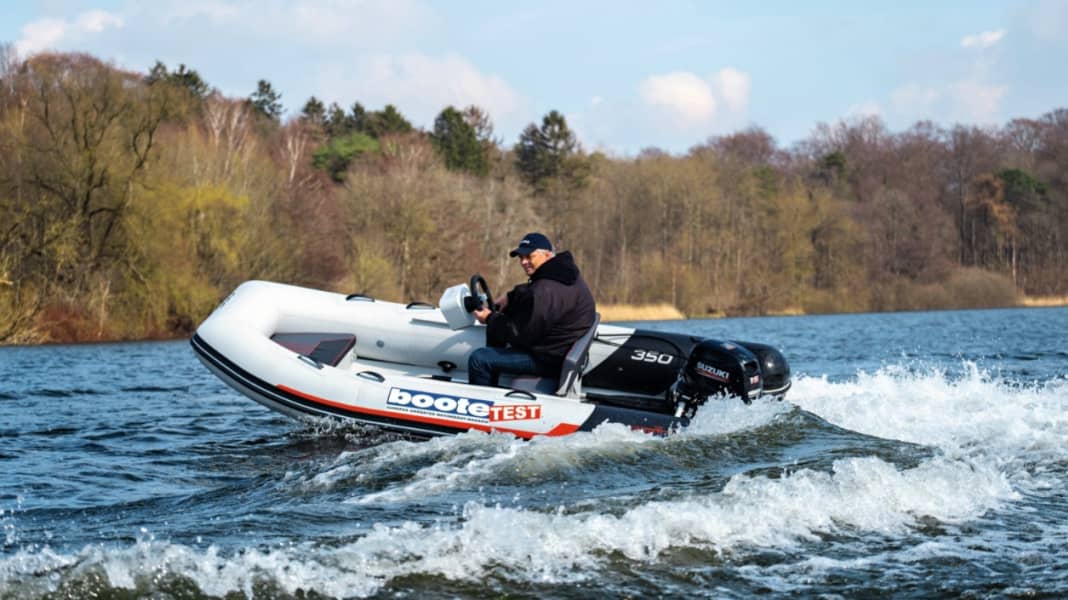
Newcomers to inflatable boats are often faced with the question: a demountable boat or a so-called RIB? As the name suggests, demountable boats (with an inlay floor or high-pressure air floor) can be conveniently dismantled for transport. The boot of an estate car is often sufficient. However, if you choose a more robust RIB - such as our Aquaspirit 350 test boat - the hull is made of solid material (aluminium) and cannot be reduced in size except for deflating the hoses. A trailer or trailer is ideal for transport. The trailer is of course better, as the boat and outboard motor can easily be lowered into the water together via the slipway and vice versa. If you have the boat on a campsite, for example, you can also get a manual slip trolley and manoeuvre the RIB with it.
Our test boat is on such a handcart, and the two of us can push it into the water in no time at all. Fold down the outboard motor, press the start button and off we go. We drive the RIB from a firmly upholstered bench seat with a sufficiently high folding backrest. The steering wheel and gearstick are located on a bracket that is firmly bolted to the bench. The gearstick and steering wheel are easy to reach and can be operated without restriction.
Need more information? You can find the test of the Aquaspirit 350 C with technical data and more pictures in BOOTE issue 06/2021 from 19.05.2021 at newsstands or online at Delius Klasing Shop.
If you push the gear lever quickly to full throttle, the bow lifts slightly and the test boat quickly starts to glide. This starts at just under 3800 rpm and ends at full throttle with 6000 rpm and a speed of just under 21 knots. With two people (approx. 200 kg), the Aquaspirit also glides easily.
Our boat runs economically at 4500 rpm, then it runs at 15 knots and consumes a meagre 0.17 l/sm. The 12-litre outboard tank is then sufficient for 55 nm plus 15% reserve. A value that is completely sufficient for this boat category, especially as a 5-litre reserve canister extends the cruising distance by 25 nm. The hull responds to fast bends with a low lean angle and true tracking radii without major lateral forces. On the imaginary slalom course, it reacts directly and swings only moderately from one side to the other. There is only a slight swerve in response to the abrupt steering input.
At slow speeds, the Aquaspirit can be steered by shifting weight, as is typical for inflatable boats, otherwise the test boat stays well on track at around 2 and 4 knots. Manoeuvrability: agile and precise, even with just one filled air chamber.
Need more information? You can find the test of the Aquaspirit 350 C with technical data and more pictures in BOOTE issue 06/2021 from 19.05.2021 at newsstands or online at Delius Klasing Shop.
There is space for the car pool on the carrying tube and on a bench in the front. A small person can join the driver on the bench. Apart from the missing main switch (to be retrofitted by the importer), the installations are neat and tidy. The same applies to the finish of the painted fixed hull and the support hose. The shipyard welds solid hot eyelets as standard so that the RIB can also be used as a dinghy. In the C version, the driving position is part of the standard equipment. However, a protective tarpaulin is on the accessories list. If you don't like the layout of our test boat, you can also order a version with a centre console and jockey seat or a boat with just two thwarts.
Conclusion
The Aquaspirit 350 C runs agilely with the 15 hp outboard, but above all safely, which is particularly advantageous for beginners. It is a robust RIB and can also be used as a dinghy on larger boats.
